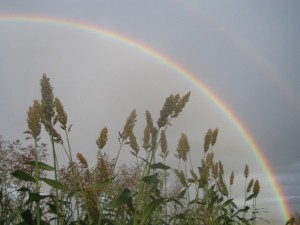Welcome to Brazil! Journey by road six hours northwest from Rio de Janeiro and you’ll arrive to Sete Lagoas, a city whose name means ‘Seven Lagoons’ in Portuguese. Although cloistered in farmlands, the city is largely a commercial centre, but also the seat of Embrapa Milho e Sorgo, the nerve centre of EMBRAPA’s maize and sorghum research, and so could pass for the ‘sede’ (Portuguese for headquarters) of the these two cereals. EMBRAPA is the Portuguese acronym for Empresa Brasileira de Pesquisa Agropecuária; the Brazilian Agricultural Research Corporation. EMBRAPA is a GCP Consortium member, and contributed to the proposal that founded GCP.
 Jurandir Magalhães (pictured), or Jura, as he likes to be referred to in informal settings such as our story today, is a cereal molecular geneticist who has been working at the Embrapa Milho e Sorgo centre since 2002. “The centre develops projects and research to produce, adapt and diffuse knowledge and technologies in maize and sorghum production by the efficient and rational use of natural resources,” Jura explains.
Jurandir Magalhães (pictured), or Jura, as he likes to be referred to in informal settings such as our story today, is a cereal molecular geneticist who has been working at the Embrapa Milho e Sorgo centre since 2002. “The centre develops projects and research to produce, adapt and diffuse knowledge and technologies in maize and sorghum production by the efficient and rational use of natural resources,” Jura explains.
Such qualities are exactly what appeal to GCP, which has supported Jura as a Principal Investigator since 2004. Beyond science and on to governance and advisory issues, Jura is also EMBRAPA’s representative on the GCP Consortium Committee.
Home and away, on a journey of discovery in sorghum
Hailing from Belo Horizonte, Minas Gerais State, where he was born, Jura attended the Federal University of Viçosa in his home state. Upon completing his Master’s degree at the university in 1995, he proceeded to USA’s Cornell University in 1998 for his PhD, under the watchful eye of Leon Kochian, another GCP Principal Investigator.

No, it’s not photo-shopped. This Australian sorghum-and-double-rainbows shot is from Supa Snappa, Andy Borrell, also a GCP sorghum Principal Investigator. See http://bit.ly/1tBAOMW
At Cornell, Jura worked with Leon on identifying the genes associated with aluminium tolerance in sorghum. “At the time, genes associated with aluminium tolerance were known for cereals in the Triticeae family (wheat, barley and rye). But the same genes were not found in the Poaceae family (sorghum, rice and maize). This suggested that there were different aluminium-tolerance genes at play, so it was a really pioneering project.” Continuing with the Cornell team after his PhD, Jura worked with Leon to map the location of a major aluminium-tolerance genetic ‘hotspot’ in sorghum, which the project team contracted to AltSB for short (aluminium-tolerance gene or locus in Sorghum bicolor). The mapping also marked the next chapter of what was to be a long-term professional relationship for the pair.
Brazil beckons, joining GCP, leadership and enduring partnerships
But in between, Brazil broke in and beckoned her native son home. And so it was that in 2002, Jura packed his bags and accepted a position with EMBRAPA’s maize and sorghum research centre. And despite the geographical distance, it wasn’t long before he and Leon teamed up again. “When I left Cornell, Leon and I had finished mapping AltSB and we were keen to clone it so we could then develop aluminium-tolerant sorghum varieties more efficiently,” says Jura.
Two years after his return to Brazil, Leon and Jura – in 2004 – submitted a joint proposal for a competitive grant for their first GCP project on aluminium tolerance in cereals, premised on AltSB. This project contributed to GCP’s foundation work on sorghum in this and other projects, the common goal being a bid to provide farmers in the developing world with sorghum crops that would be able to tolerate harsh soils. But the project contributed much more with a deep taproot in pre-history, as that which we today call ‘sorghum’, ‘maize’ and ‘rice’ were once one millions of ‘Jurassic’ years ago. More on that interesting side-story.
And since this first project, EMBRAPA and Cornell University have collaborated with several other research institutes around the world, particularly in Africa.

Left to right (foreground): Leon, Jura and Sam Gudu (Moi University) examine crosses between Kenyan and Brazilian maize, at the Kenya Agricultural Research Institute (KARI), Kitale, in May 2010.
Jura leads several EMBRAPA and GCP collaborative projects across three continents (Africa, Asia and the Americas). The partnerships forged by and through these projects go well beyond project life and frame, and will therefore continue after GCP’s sunset. Jura is both team leader and team player. And a couple of GCP projects in which Jura is part of the project team will run on in 2015 (see page 10), after GCP’s closure in December 2014.
Links
- Jura’s project page | project update (pages 52–53)
- For a glimpse of Jura’s waork in its early stages, flip to page 29 – Locking our a cereal killer
- Comparative genomics in cereals – Research Initiative| Blogposts | InfoCentre | Genomic research products: use filter to search for your crop of interest | closing story from our Sunset Blog
- Sorghum – Blogposts | Slides | Research products | InfoCentre
- Jura’s slides on his work below







